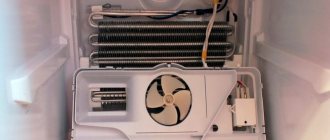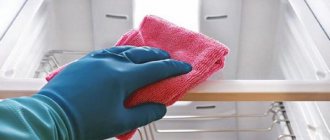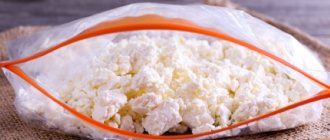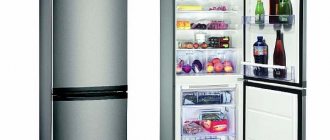Everyone in the house has a refrigerator - the main assistant for housekeeping and food storage. It requires careful care in order to function for a long time. During operation, ice build-up occurs on the internal surfaces of the refrigerator. This process is facilitated by the evaporation of moisture and the penetration of warm air from outside.
If the ice is not removed in time, the load on the compressor will gradually increase, eventually leading to a malfunction. And also the formed ice reduces free space and increases electricity consumption. It is recommended to carefully monitor this process and defrost the refrigerator regularly.
Defrosting frequency
It is better to wash the internal surfaces thoroughly.
The instructions for using the device will tell you how often you need to defrost the refrigerator. The regularity of this process directly depends on the method of defrosting. Types of defrosting:
- Manual;
- Drip;
- No frost.
Manual defrosting - in high-quality refrigerators this means that once a year you will have to turn off the device and remove frost and ice from the freezer.
Pour out the melt water and wash the internal surfaces thoroughly. The process takes about 3-4 hours.
With drip system
Pros and cons of a refrigerator with a drip system
Drip system - used in many modern refrigerators, it is quite productive and easy to maintain.
The principle of operation is that an evaporator is located on the back surface of the refrigerating chamber, with a drain located underneath it.
While the compressor is on, ice forms on the wall. After turning off, the ice begins to melt, the drops flow into the drain, and then into a special reservoir for liquid.
From there the moisture evaporates. The defrosting schedule and time are set automatically and do not require user intervention.
No frost
Pros and cons of the No frost refrigerator
No frost - the main feature is the presence of an evaporator and powerful fans. Due to them, automatic defrosting and operation occurs without the formation of frost and ice.
Requires virtually no maintenance, cools evenly, and maintains the desired temperature. Experts recommend doing defrosting yourself once every 12 months.
With automatic defrosting system
In expensive devices with an automatic defrosting system, the user does not need to think about the frequency of this process since the automation will do everything on its own.
As a rule, this is programmed to happen once a month - the device does not need to be disconnected from the network.
Why do you need to defrost a refrigerator?
A snow “coat” always forms on the walls of the freezer, unless it is an automatic No Frost system. Moisture from the air, from products placed in the compartments of the device, condenses on the walls of the heat exchanger and turns into a solid state, that is, snow, ice.
Consequences of improper refrigerator care
Having a lower heat transfer coefficient, this layer acts as an insulator, which leads to the following consequences:
- Cooling system overload. The temperature sensor gives a signal to start, the compressor works, but the “fur coat” significantly slows down the cooling of the air, which changes the normal functioning of the entire system;
- Depreciation of equipment. Working with increased load, the refrigerator significantly reduces the life of the device and creates risks of emergency defects and breakdowns of individual elements and mechanisms;
- Increased energy consumption. The periods of the active phase of compressor operation increase. In other words, the compressor actually runs idle, using up its allocated resource;
- Violation of storage temperature conditions. The difference can reach values that are critical for some types of products and medicines located in the refrigerator. Shelf life directly depends on temperature. A deviation of even a few degrees may be sufficient to cause damage.
These troubles can be avoided by regular procedures to remove excess snow and ice. It should be added that working under increased load can cause more unpleasant situations. Despite the fact that the system is equipped with emergency protection devices, there is a danger of damage to household wiring and fires. This happens extremely rarely, but it should not be neglected.
The absence of ice is the key to proper and economical operation of the refrigerator.
Preparing for the defrosting process
The main rule that must be followed when defrosting the refrigerator is not to start work if you have a lot of food and do not have a temporary place for their proper storage.
Do not use a construction or household hair dryer or heaters for this purpose; it is unsafe. Do not apply chemical reagents as they can damage the device.
If rubber seals do not function well, try lubricating them with silicone or vegetable oil.
To avoid compressor breakdown, it is recommended to turn it on after at least 12 hours. Try to open the doors as little as possible in the next 3 hours so that the device has the opportunity to quickly create the desired microclimate.
How to properly clean an LG No Frost refrigerator after defrosting
Cleaning up the inside of the LG No Frost refrigerator
- When cleaning a household appliance, start by cleaning its internal parts, moving from top to bottom and paying special attention to the corners of the chambers;
- do not forget to wash and disinfect the drain hole on the back wall of the refrigerator compartment: clean it with a brush, then draw detergent into a syringe (without a needle) and pour it into the channel;
- clean the holes on the fan grille with cotton swabs soaked in cleaning product;
- wash the outer parts of the case, wipe the condenser located on the back wall with a slightly damp sponge;
- Wash the sponge or rag from any remaining cleaning products, fill a bowl with water and rinse all surfaces with it;
- take a dry towel and wipe the refrigerator inside and out;
- leave the device with the door open so that all moisture from the internal surfaces completely evaporates;
- Reinstall the shelves and drawers in their original place, plug in the device and after half an hour place the food in it.
IMPORTANT! According to the recommendations of manufacturers of refrigerators with a no-frost system, such units can only be connected to the network 12 hours after being turned off.
LG No Frost refrigerator cleaning products
To wash your refrigerator, you can use both chemicals and homemade products.
Dish detergent:
- pour hot water into a bowl, add a couple of teaspoons of washing gel to it, mix the ingredients until foam forms;
- soak a soft sponge in the solution, wipe all elements previously removed from the device (shelves, grilles, drawers) and the internal and external surfaces of the refrigerator;
- After removing dirt, be sure to rinse off any remaining cleaning product with water.
Other chemicals in the form of various sprays, liquids, foam, wet wipes (Top House, Silit Bang, Horse) are also suitable for cleaning the refrigerator.
In addition to excellent cleaning properties, which allow housewives to get rid of contaminants in the device in a short time, most of these products also have disinfecting abilities.
IMPORTANT! When working with special preparations, do not forget to wear rubber gloves. After cleaning surfaces, be sure to wipe them with a cloth dampened in clean water.
Traditional methods will also help you rid your refrigerator of stains of various origins:
- make a soda solution from 2 tablespoons of powder and 1 liter of water, treat the inner walls of the chambers with it, rinse the surfaces with water;
- grate half a bar of laundry soap, mix the shavings with warm water. Use the product to remove dirt from problem areas;
- dampen the sponge in hydrogen peroxide (3%) and wash the chambers.
The sealing tape on the door of the device can also be cleaned with dishwashing detergent and hydrogen peroxide.
The use of vinegar, soda to remove mold or grease from a rubber element is unacceptable, since these substances can damage the part and break the seal of the chambers.
If you notice that the tape has lost its elasticity, apply a little olive oil to a rag and rub it into the seal.
IMPORTANT! To clean the refrigerator, do not use aggressive chemicals (containing chlorine, concentrated acids, alkalis) or abrasives. Treat the surfaces of electrical appliances only with soft cloths or sponges.
Getting rid of unpleasant odors in the LG No Frost refrigerator
The appearance of unpleasant odors in the device is most often associated with improper storage of products (failure to comply with product rules, storage of spoiled food, etc.).
To get rid of the “aroma,” first of all, find out and eliminate the cause of its occurrence.
The following methods will help eliminate strong odors from the refrigerator:
- mix vinegar and water in equal proportions and wash the inner walls of the chamber;
- crush 20-30 tablets of activated carbon, pour it onto plates or into gauze bags, place the product inside the refrigerator;
- crushed citrus peels (lemon, orange), black tea, sugar, rice, vanilla, coffee beans (grind them first) “absorb” various aromas well: as in previous cases, place the products in bags made of linen fabric, gauze, put inside a household devices.
Special balls for refrigerators, which are sold in household chemical stores, effectively eliminate even the most pungent odor.
The mineral components they contain destroy the unpleasant “amber” and prevent the appearance of mold. The balls are effective for 3-4 months; after this period, the drugs should be replaced with new ones.
ADVICE! Don't forget to take care of the device if you need to leave for a long time: defrost, wash the device and leave it unplugged, with the door open.
Carry out periodic checks of the products in the unit, throw away food that has expired, store food in special containers closed with a lid.
Cleanliness in the refrigerator is not only the key to your health, but also to the long life of your kitchen appliances.
Rules for defrosting the refrigerator
Remove shelves and drawers before defrosting
Before starting work, read the device data sheet to ensure that you follow the instructions correctly and do not harm the equipment. Let's take a step-by-step look at how to defrost a refrigerator:
- To gain time, turn off the power to the device before you start uploading the contents.
- Install a container to collect melt water, place them inside, and cover the floor with a rag.
- Remove shelves and drawers in advance.
- It is not advisable to defrost at high room temperatures.
- If you have a lot of time, just open the doors and wait for it to defrost. But this will take many hours.
- To speed up the process, you can place pots of warm water inside the device and change it periodically to maintain heat. After half an hour the ice should melt.
- To remove ice layers, do not use sharp metal objects. A plastic spatula is suitable for this purpose. Wipe the insides with a warm cloth or sponge, this will help remove any remaining ice faster.
- As a detergent, dilute baking soda in water, do not use chemicals or chlorine.
- Wipe dry the refrigerator compartment, all shelves and trays. Do not use abrasives to avoid damaging the surfaces.
- Treat the seals with a solution of citric acid to prevent the development of mold.
- Make sure that water does not get inside the device and cause a short circuit in the system.
- Clean the ventilation grilles in place using damp cotton pads.
- Gently wipe the body with a soft sponge soaked in soapy water, then walk with a dry towel.
- Ventilate the interior chambers and begin arranging drawers and shelves.
- Plug it in after the allotted time and leave it empty.
- Place the products in their places and continue using them.
What should you not do?
- Do not use vinegar or similar substances to clean your refrigerator. They eat away plastic.
- Do not chip or scrape ice with a knife. Using this method, you will ruin not only the plastic surface itself, but also the channel underneath it, which can lead to serious damage to the device.
- When heating the ice layer with a hairdryer or fan heater, do not let the air flow directly onto the door rubber.
- Do not rub the walls of the device with abrasive sponges or powders. They can also damage the surface of the equipment.
When cleaning the refrigerator, it is unacceptable to use metal brushes, rough sponges, or abrasive cleaning agents.
Do I need to defrost my freezer?
If you notice the formation of frost and ice, then defrosting should begin immediately.
Yes, it is necessary, in refrigerators with manual and drip systems. To do this, you will have to turn off the power to the device and create the optimal temperature for melting the ice. In a refrigerator with two compressors, turn off only the freezer compartment.
To speed up the process, open the door and let in warm air from the room.
After defrosting is completed, the refrigerator will need some time to return to its previous cooling temperature. Do not rush to think that a breakdown has occurred, give it time to return to its previous operating mode.
To avoid breakdowns, it is recommended to defrost refrigerators with know frost once a year. But if the formation of frost and ice is noticed earlier, start immediately.











